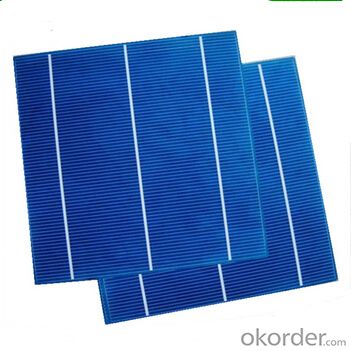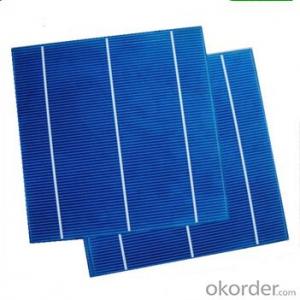Polycrystalline Solar Cells Series- 16.00%-18.20%
- Loading Port:
- Shanghai
- Payment Terms:
- TT OR LC
- Min Order Qty:
- 3000 pc
- Supply Capability:
- 300000 pc/month
OKorder Service Pledge
OKorder Financial Service
You Might Also Like
Solar Cells:
Solar cells is made by solar wafer, it has three categories of solar cell right now, monocrystalline polycrystalline and thin film,These cells are entirely based around the concept PN junction, which is the critical part of solar module, it is the part that can convert the light energy into electricity, the thickness is from 180um to 200um, with even busbars to conduct electricity, textured cell can decrease diffuse reflection; they are often electrically connected and encapsulated as a module. Photovoltaic modules often have a sheet of glass on the front (sun up) side, allowing light to pass while protecting semiconductor wafers from abrasion and impact due to wind-driven debris, rain, hail, etc. Solar cells are also usually connected in series in modules, creating an additive voltage. Connecting cells in parallel will yield a higher current;With high quality and stable quality. Our Cells can greatly improve the performance of Solar Modules.
Features:
1. High conversion efficiencies resulting in superior power output performance.
2. Proven long term mechanical stability of silicon
3. Make of highly purified poly silicon
4. Three bus bars for reduced series resistance and improved module and cell efficiency
5. Blue anti-reflecting coating ensures improved light absorption and increased efficiency
6. Acid texturization offers a uniform appearance and virtually invisible crystal structure
7. Excellent low light behavior for improved energy yield
Solar Cells Advantage:
1. Tire-1 Solar Cells’ Manufacturer Quality Guarantee. With a complete and sophisticated quality government system, our Quality Management have arrived world’s leading place. Customer can receive Tire-1 Cells Maker’s Quality Standard Products.
2. Trusted Warranty. We can supply trusted after-sales service to our customer. If our cells are found not in conformity to the specification of manufacturer, or should the inspected quantity found in shortage, or should the packing found damaged, the buyer has the right to claim to the seller. The claim, if any, should be presented to seller within 30 days after cargo's arrival date to the port, together with related inspection report and photos issued and provided by a reputable independent surveyor such as SGS.
3. World’s Leading Manufacturer Equipment. We imported the newest and leading production equipment from abroad. Advanced equipment can guarantee the stable quality of cells. Auto production line can also save labor cost which will further cut our production cost.
4. Bulk supply: With the production capacity of 500MW, we can produce large quantity every month. This can satisfy most customer requirement.
Specifications:
Mechanical Data and Design | Intensity Dependence | |||||||||
Cells | Poly6"(R220) crystal | Intensity[W/m2] | Isc *[mA] | Voc*[mV] | ||||||
Format | 156mm*156mm±0.5mm | 1000 | 1 | 1 | ||||||
Thickness | 190um±20um | 900 | 0.9 | 0.994 | ||||||
Front(-) | 1.4mm bus bars (silver), | 500 | 0.5 | 0.969 | ||||||
blueanti-reflectingcoating (silicon nitride) | 300 | 0.3 | 0.946 | |||||||
Back(+) | 3mm wide soldering pads (silver) | 200 | 0.2 | 0.926 | ||||||
Back surface field (aluminium) | ||||||||||
Electrical typical values | ||||||||||
Product model | Eff. % | Pmax (W) | Vpm(V) | Ipm (A) | Voc(V) | Isc(A) | ||||
18.20%-4.429W | EFF≥18.20% | Pmax ≥4.429 | 0.535±3 | 8.2785 | 0.636 | 8.815 | ||||
18.00%-4.380W | 18.20%>EFF≥18.00% | 4.429>Pmax ≥4.380 | 0.534±3 | 8.2022 | 0.635 | 8.753 | ||||
17.80%-4.332W | 18.00%>EFF≥17.80% | 4.380>Pmax ≥4.332 | 0.533±3 | 8.1088 | 0.634 | 8.704 | ||||
17.60%-4.283W | 17.80%>EFF≥17.60% | 4.332>Pmax ≥4.283 | 0.531±3 | 8.0662 | 0.633 | 8.620 | ||||
17.40%-4.234W | 17.60%>EFF≥17.40% | 4.283>Pmax ≥4.234 | 0.530±3 | 7.9896 | 0.632 | 8.610 | ||||
17.20%-4.186W | 17.40%>EFF≥17.20% | 4.234>Pmax ≥4.186 | 0.529±3 | 7.9127 | 0.631 | 8.529 | ||||
17.00%-4.137W | 17.20%>EFF≥17.00% | 4.186>Pmax ≥4.137 | 0.527±3 | 7.8503 | 0.630 | 8.459 | ||||
16.80%-4.088W | 17.00%>EFF≥16.80% | 4.137>Pmax ≥4.088 | 0.524±3 | 7.8024 | 0.629 | 8.397 | ||||
16.60%-4.040W | 16.80%>EFF≥16.60% | 4.088>Pmax ≥4.040 | 0.521±3 | 7.7539 | 0.627 | 8.239 | ||||
16.40%-3.991W | 16.60%>EFF≥16.40% | 4.040>Pmax ≥3.991 | 0.519±3 | 7.6900 | 0.625 | 8.198 | ||||
16.20%-3.942W | 16.40%>EFF≥16.20% | 3.991>Pmax ≥3.942 | 0.516±3 | 7.6404 | 0.623 | 8.153 | ||||
16.00%-3.894W | 16.20%>EFF≥16.00% | 3.942>Pmax ≥3.894 | 0.514±3 | 7.5754 | 0.620 | 8.145 | ||||
Temperature Coefficients | TkVoltage | -0.348%/K | ||||||||
TkCurrent | +0.031%/K | |||||||||
TkPower | -0.46%/K | |||||||||

FAQ
We have organized several common questions for our clients,may help you sincerely:
①What price for each watt?
It depends on the efficiency of the solar cell, quantity, delivery date and payment terms.
②How long can we receive the product after purchase?
In the purchase of product within three working days, We will arrange the factory delivery as soon as possible. The pecific time of receiving is related to the state and position of customers.Commonly 7 to 10 working days can be served.
③Can you provide the peripheral products of the solar panels, such as the battery, controller, and inverter? If so, can you tell me how do they match each other?
Yes, we can, we have two companies for solar region, one is CNBM International, the other is CNBM engineering Co.
We can provide you not only the solar module but also the off grid solar system, we can also provide you service with on grid plant.
④What is your warranty of solar cell?
Our product can promise lower than 0.3% open box crack, we support claim after opening the box if it has crackm color difference or sth, the buyer should give pictures immediately, we can not accept the claim after the solar cell has assembled to solar panel.
• Timeliness of delivery
• ⑤How do you pack your products?
We have rich experience on how to pack the solar cell to make sure the safety on shipment, we could use wooden box or pallet as buyer's preference.
- Q:What is the role of bypass diodes in shading situations?
- The role of bypass diodes in shading situations is to minimize the impact of shade or partial shading on the performance of solar panels. When a solar panel is partially shaded, the shaded cells can create a significant drop in voltage, reducing the overall electrical output. Bypass diodes are connected in parallel with the shaded cells, allowing the current to bypass the shaded area and flow through the diode. This helps to maintain a higher voltage and prevent the shaded cells from negatively affecting the performance of the entire solar panel.
- Q:Can solar cells be used for powering remote communication towers?
- Yes, solar cells can be used to power remote communication towers. Solar panels can be installed on the towers or nearby to capture sunlight and convert it into electricity. This renewable energy source is ideal for remote locations where access to traditional power grids may be limited or costly. Solar cells can provide a reliable and sustainable power supply for remote communication towers, enabling them to function efficiently.
- Q:Can solar cells be used on vehicles other than cars?
- Yes, solar cells can be used on vehicles other than cars. Solar cells can be integrated into various types of vehicles including buses, motorcycles, bicycles, boats, and even spacecraft. The energy generated by solar cells can be used to power the vehicle's electrical systems, reduce reliance on fossil fuels, and contribute to a more sustainable transportation infrastructure.
- Q:Can solar cells be used in off-grid cabins or cottages?
- Yes, solar cells can definitely be used in off-grid cabins or cottages. Solar cells, also known as photovoltaic cells, convert sunlight into electricity, making them an excellent renewable energy source for remote locations. By harnessing the power of the sun, solar cells can generate electricity to power lights, appliances, and other electrical devices in off-grid cabins or cottages, allowing for a sustainable and independent energy solution.
- Q:How much does a solar cell weigh?
- The weight of a solar cell can vary depending on its size and type, but on average, a standard-sized solar cell weighs around 6 ounces or 170 grams.
- Q:Can solar cells generate electricity on cloudy days?
- Yes, solar cells can generate electricity on cloudy days, although their efficiency is reduced compared to sunny days. The cells can still convert the diffuse sunlight that penetrates through the clouds into electricity, albeit at a lower rate.
- Q:Can solar cells be used for powering hotels?
- Yes, solar cells can be used for powering hotels. Solar energy is a clean and renewable source of power that can be harnessed through the use of solar cells, also known as photovoltaic panels. These panels convert sunlight into electricity, which can be utilized to power various appliances and systems in hotels. By installing solar panels on rooftops or in open spaces, hotels can reduce their reliance on conventional energy sources, lower their carbon footprint, and potentially save on electricity costs in the long run.
- Q:Can somebody list some of the materials used for making solar cells?
- Solar cells are typically named after the semiconducting material they are made of.
- Q:Can solar cells be used to power remote weather stations?
- Yes, solar cells can be used to power remote weather stations. Solar cells convert sunlight into electricity, providing a reliable and sustainable power source for remote locations. This eliminates the need for traditional power grid connections and reduces operating costs. Additionally, solar cells can be easily installed and maintained in remote areas, making them an ideal solution for powering weather stations in such locations.
- Q:What is the payback period for solar cell installations?
- The payback period for solar cell installations varies depending on factors such as the cost of the installation, the amount of energy generated and consumed, and any applicable incentives or subsidies. On average, it can range from 5 to 10 years, but it is important to conduct a specific analysis considering individual circumstances to determine the accurate payback period for a given solar cell installation.
1. Manufacturer Overview |
|
|---|---|
| Location | |
| Year Established | |
| Annual Output Value | |
| Main Markets | |
| Company Certifications | |
2. Manufacturer Certificates |
|
|---|---|
| a) Certification Name | |
| Range | |
| Reference | |
| Validity Period | |
3. Manufacturer Capability |
|
|---|---|
| a)Trade Capacity | |
| Nearest Port | |
| Export Percentage | |
| No.of Employees in Trade Department | |
| Language Spoken: | |
| b)Factory Information | |
| Factory Size: | |
| No. of Production Lines | |
| Contract Manufacturing | |
| Product Price Range | |
Send your message to us
Polycrystalline Solar Cells Series- 16.00%-18.20%
- Loading Port:
- Shanghai
- Payment Terms:
- TT OR LC
- Min Order Qty:
- 3000 pc
- Supply Capability:
- 300000 pc/month
OKorder Service Pledge
OKorder Financial Service
Similar products
New products
Hot products
Hot Searches
Related keywords



























